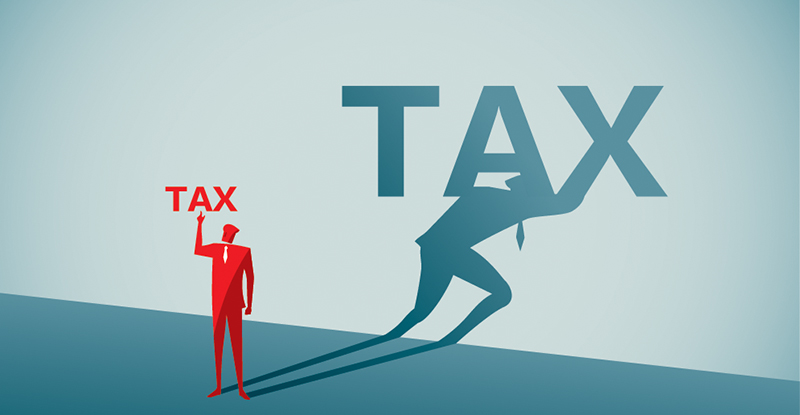
Editor’s note: This article was written prior to the release of the Department of Finance’s draft legislation on substantive Canadian-controlled private corporations on August 9, 2022, and does not address the proposed amendments. Readers can access https://fin.canada.ca/drleg-apl/2022/ita-lir-0822-l-2-eng.pdf for details.
Federal Budget 2022 contains proposed measures designed to achieve integration and remove any tax deferral advantages associated with investing through a corporation. As described in this article, if these proposals are approved, earning investment income may become more costly for entities that are substantively Canadian-controlled private corporations (CCPCs)1 and for CCPCs with investments held through controlled foreign affiliates (CFAs).2
Integration
Integration, a central concept of the Canadian income tax system, aims to ensure that income earned through a corporation and distributed to a Canadian resident individual is subject to a similar tax rate as if it were earned directly by that individual. For CCPCs, active business income is taxed at a lower rate (11%3 or 27% in BC) and integrated once dividends are paid, whereas investment income is integrated immediately through a higher rate of additional refundable taxes4 (50.7% in BC, 30.7% of which is refundable)—this means there is no tax deferral advantage to holding the investment within the corporation.
In contrast, non-CCPCs are subject to the same corporate tax rate (27% in BC) regardless of the type of income earned, which creates advantages when earning investment income.
Substantive CCPCs
Seeking these advantages, certain taxpayers have attained non-CCPC status by, for example, migrating corporations under foreign corporate law (while maintaining central management and control in Canada), interposing non-resident corporations into the corporate structure, or issuing options to non-residents.
Budget 2022 seeks to address this issue by making it so that a private corporation (other than a CCPC) can be deemed a “substantive CCPC” if, at any time during the taxation year, the entity is either: “a) controlled, directly or indirectly in any manner whatever, by one or more Canadian resident individuals, or b) would, if each share of the capital stock of a corporation that is owned by a Canadian resident individual were owned by a particular individual, be controlled by the particular individual.”5 Additionally, if a newly proposed anti-avoidance rule applies, a corporation could be “deemed to be a substantive CCPC if it is reasonable to consider that one of the purposes of any transaction … or series of transactions, was to cause the corporation not to qualify as a substantive CCPC.”6
Accordingly, even if a Canadian resident individual holds less than 50% of the shares, a corporation could still be deemed a substantive CCPC if that Canadian resident individual has de facto control. As well, if Canadian resident individuals collectively own more than 50% of a corporation’s voting shares, the corporation could be deemed a substantive CCPC—even if the individuals are unrelated and each own less than 50%.
Under the proposed rules, investment income in a substantive CCPC would be subject to the higher rate of additional refundable taxes (50.7% in BC) instead of the general corporate tax rate (27% in BC). Furthermore, the investment income of a substantive CCPC could not be paid out as lower-taxed eligible dividends, and the normal assessment period for Part IV tax would be extended by one year. The proposed rules for substantive CCPCs apply to taxation years that end on or after April 7, 2022, with limited exceptions for transactions entered into before April 7, 2022, and closing in 2022.7
Although the proposed rules narrow the corporate tax rate differential on investment income, they do not achieve perfect integration on a flow-through basis. In fact, taxpayers may want to invest as individuals and avoid earning corporate investment income if there is a risk of a corporation being deemed a substantive CCPC, given the higher corporate tax rate and non-eligible dividend tax rate.
CCPCs with foreign accrual property income
To deter Canadian taxpayers from gaining tax deferral advantages by moving passive investment income offshore, the foreign accrual property income (FAPI) rules impute a CFA’s FAPI to a Canadian shareholder’s income in the year the FAPI is earned. Without these rules, Canadian taxpayers would potentially be able to transfer their investments to their CFAs and avoid paying Canadian tax on that income until it is repatriated to Canada.
FAPI includes income from property and taxable capital gains from investing activities. Relief from double taxation may be available through a grossed-up deduction8 equal to the foreign accrual tax9 (FAT) paid in respect of the FAPI, multiplied by a relevant tax factor (currently, 4.0 for corporations and 1.9 for all other taxpayers). On repatriation, deductions may be available to offset the dividend income to the Canadian shareholder.10 Moreover, certain deductions11 are also added to the CCPC’s “general rate income pool” (GRIP), from which lower-taxed eligible dividends can be distributed.
Since the FAPI rules and the relevant tax factor do not distinguish between different tax rates applicable to different Canadian corporations, and since certain repatriations of FAPI entitle the CCPC to distribute funds through lower-taxed eligible dividends, there is a perceived tax deferral advantage.
To address this issue, Budget 2022 proposes to reduce the FAT deduction by dropping the relevant tax factor from 4.0 to 1.9 and eliminating any associated GRIP additions for CCPCs and substantive CCPCs. To compensate for the higher corporate tax rate and the loss of the GRIP addition, certain amounts12 would be added to the capital dividend amount (CDA) of the CCPC or substantive CCPC. These proposed measures would apply to taxation years that end on or after April 7, 2022, even though draft legislation had not been released as of this writing in late July 2022.
The proposed rules would likely result in net FAPI inclusions to many CCPCs since the minimum foreign tax rate needed to fully shelter FAPI would be 52.63%, rather than the current rate of 25%. Since FAPI is taxed at a higher refundable tax rate than active business income, CCPCs would be incentivized to distribute these funds to their shareholders on a current basis (rather than retain them at the corporate level) to obtain a dividend refund, thereby foregoing a corporate tax deferral. However, it appears that even if CDA additions are replaced with GRIP additions, the reduced relevant tax factor would still make it more costly for a Canadian taxpayer to invest through a CFA owned by their CCPC rather than investing as an individual.
Effective flow-through tax rates
The following table outlines the effective tax rates on $100 of investment income earned and distributed to a Canadian individual shareholder. As shown below, investing through an individual is the most tax-efficient method, and investing through a general corporation results in a slightly higher flow-through tax rate but provides for a deferral of personal tax if the funds are kept at the corporate level. Due to the higher refundable tax rate, the least tax-efficient way to invest is through a CCPC or substantive CCPC.
Additionally, for CCPCs with foreign investments, it appears that it would still be more advantageous on a flow-through basis to invest through a CFA than a CCPC, despite the loss of a tax deferral under the proposed changes in Budget 2022.
|
Investments held by |
Individual |
General corporation |
CCPC and substantive CCPC |
CFA of CCPC (current rules) |
CFA of CCPC and substantive CCPC (Budget 2022) |
|
Investment income |
$100.00 |
$100.00 |
$100.00 |
$100.00 |
$100.00 |
|
Less: Foreign corporate tax and withholding tax13 |
N/A |
N/A |
N/A |
(28.75) |
(28.75) |
|
Subtotal |
$100.00 |
$100.00 |
$100.00 |
$71.25 |
$71.25 |
|
Less: Canadian corporate tax14 |
N/A |
(27.00) |
(20.03)15 |
–16 |
(9.09)17 |
|
Subtotal |
$100.00 |
$73.0018 |
$79.9719 |
$71.2520 |
$62.1621 |
|
Less: Personal tax22 |
($53.50) |
($26.67) |
($39.10) |
($26.03) |
($17.74) |
|
After-tax proceeds to individual |
$46.50 |
$46.33 |
$40.87 |
$45.22 |
$44.42 |
|
Effective flow-through tax rate |
53.50% |
53.67% |
59.13% |
54.78% |
55.58% |
Takeaway
The proposed changes in Budget 2022 could increase the effective flow-through tax rates on investment income by over 5% for BC residents earning investment income through substantive CCPCs and by 0.8% for those earning investment income through CCPCs with FAPI. Accordingly, BC taxpayers may want to think twice about earning investment income through a corporation in the future if there’s any risk of the corporation being deemed a substantive CCPC or if they’re seeking a corporate tax deferral on their FAPI.
Wynn Vo, CPA, CA, is a partner with KPMG Canada’s international corporate tax practice in Vancouver, where she advises Canadian and foreign public companies and private enterprises, as well as their respective stakeholders, on a broad range of Canadian and international tax matters.
This article was originally published in the September/October 2022 issue of CPABC in Focus.
Footnotes
1 Defined under subsection 125(7) of Canada’s Income Tax Act (the Act) as a private Canadian corporation that is not controlled, directly or indirectly in any manner whatever, by non-resident persons, certain public corporations, or any combination thereof. Unless otherwise specified, all statutory references in this article are to the Act.
2 Defined under subsection 95(1).
3 For small business income up to $500,000.
4 Refers to tax on portfolio dividends (Part IV) and refundable tax on other passive income (Part I).
5 Pursuant to the proposed definition of “substantive CCPCs” under subsection 248(1).
6 Pursuant to proposed subsection 248(43).
7 An exception may be available if the corporation’s taxation year ends because of an acquisition of control caused by the sale of all or substantially all of the corporation’s shares to an arm’s-length purchaser if the purchase and sale agreement was entered into before April 7, 2022, and the share sale occurs before the end of 2022.
8 Under subsection 91(4).
9 Defined under subsection 95(1).
10 Under subsection 91(5) in respect of previously taxed FAPI—paragraph 113(1)(b) refers to corporations in respect of FAT, and paragraph 113(1)(c) refers to corporations in respect of foreign withholding tax paid on the distribution.
11 Refers to deductions defined in section 113.
12 Budget 2022 proposes to increase the capital dividend account balance of a CCPC or substantive CCPC by the amount of inter-corporate dividend deductions claimed with respect to hybrid surplus dividends (less withholding tax paid) and taxable surplus dividends and withholding tax on taxable surplus dividends (less withholding tax paid).
13 Assumes the CFA is subject to 25% foreign corporate tax and 5% foreign dividend withholding tax.
14 Assumes this is a Canadian corporation with permanent establishment in BC.
15 Represents non-refundable portion of Part I tax.
16 FAPI of $100 should be fully sheltered by a 91(4) FAT deduction ($25 x 4). Dividend income of $75 should be fully sheltered by a 113(1)(b) deduction ($25 x (4-1)).
17 Net FAPI of $52.50 ($100 – FAT deduction ($25 x 1.9)) should be fully sheltered by a 91(5) deduction. Net dividend income of $45.38 ($75 – 113(1)(b) deduction ($25 x (1.9-1)) – 113(1)(c) deduction ($3.75 x 1.9)) subject to 20% non-refundable Part I tax.
18 Distributed as an eligible dividend.
19 Distributed as a non-eligible dividend.
20 Distributed as an eligible dividend.
21 Assumes $25.88 is distributed as a tax-free capital dividend (amount subject to change on release of draft legislation) and remainder is distributed as a non-eligible dividend.
22 Assumes the BC resident individual is subject to tax at the highest marginal rate.



